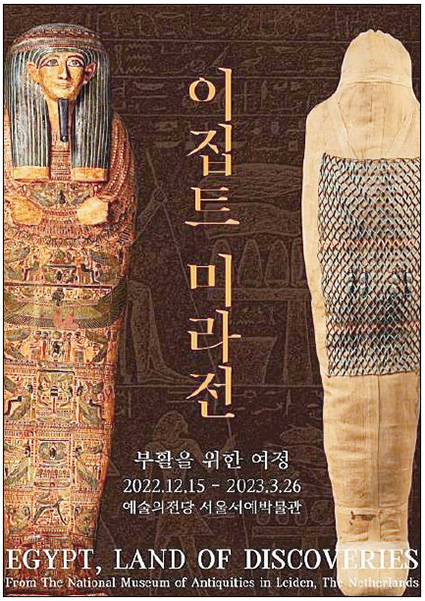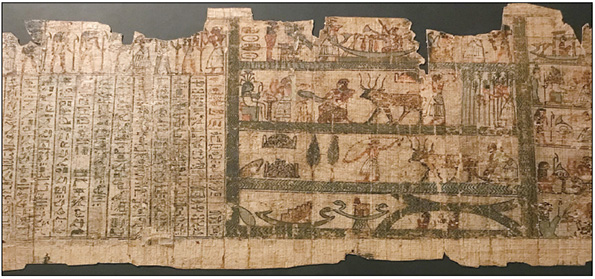
Have readers heard about “mummy?” Mummy means a human or animal body that has been preserved to its original form through several procedures. Readers can check CT scans images to confirm that there is a mummy in a coffin at EGYPT, LAND OF DISCOVERIES. This exhibition is on view at the Seoul Calligraphy Museum, the Seoul Arts Center on the end of March. Readers can know about ancient Egyptians’ cultures, languages seeing relics so get an opportunity to experience their lives.
Do readers know that an exhibition about relics from Ancient Egypt is on view?

EGYPT, LAND OF DISCOVERIES is on view at the Seoul Calligraphy Museum, the Seoul Arts Center from last Dec. 15 to Mar. 26. The exhibition is hosted by The National Museum of Antiquities in Leiden, The Netherlands, one of the world’s top five Egyptian collections. The exhibition is available from 10 a.m. to 10 p.m. on Tuesdays to Sundays, and the adult admission fee is 20,000 KRW. Also, the Egyptian mummy exhibition offers a free audio guide, so please use the audio guide when visiting. This CBT reporter visited the exhibition on Dec. 25, 2022. When the reporter was young, thinking about ancient Egyptian culture was interesting and she wanted to see Egyptian relics at least once, so the reporter went to watch the Egyptian mummy exhibition.
EGYPT, LAND OF DISCOVERIES consists of four parts.
PART 1 : EXPLORATION, PASSION FOR ANCIENT EGYPT reveals various aspects of Ancient Egypt that Napoleon encountered when he began his military expedition to Egypt. The National Museum of Antiquities in Leiden, The Netherlands, supported an archaeological survey of Egypt and was finally able to discover relics from several Egyptian regions. As such, in PART 1, there are the Tutankhamun statue, the painting of Ramesses II fighting against his enemies, the fragment of the oil lamp, the complex body of Abusir, and the duplicate of the Rosetta Stone. Tuntankhamun was the 13th Pharaoh of the New Kingdom of Egypt, and he is one of the most famous Pharaohs. Pharaoh means king in Egyptian.
PART 2 : MEETING, THE FATEFUL OF ANCIENT EGYPT reveals the history and the religion of Ancient Egypt. Egypt developed a complex culture through trade, not a single culture, but a mixture of various cultures. That’s how colorful Egyptian civilization came about. The Egyptians thought that the spirits of the gods they believed in were embedded in statues, so it was very important for the ancient Egyptians to make statues. In this part, visitors can watch the Stela of Pamaaf, the Upper Part of a False Door of Neferenkhufu, the Stela of Amenemheb, the Scorpion, and the Stela of Hor.
PART 3 : UNDERSTANDING, THE LIFE AND COGNITION OF THE EGYPTIANS reveals the reason why Egyptians were obsessed with the afterlife. The ancient Egyptians became more obsessed with the afterlife because their lifespan was not long. The Egyptians who wanted to live eternally in the afterlife were mummified because they believed that the body must remain so that the spirit can return and live in the afterlife forever. In this part, visitors can see some mummy coffins. There are the Coffin of Haytemhat, the Outer Coffin of Hor, and the Outer Coffin of Panesy. Visitors also can enjoy a Necklace with Amulets and Beads, a Glass Vase, a Model of a Brewery, and the Hathor Amulet.
PART 4 : SCAN THE BARE FACE OF ANCIENT EGYPT, visitors can see CT scans of the mummies or artifacts. This video proves that there is actually a human or animal body in the mummy, without having to perform hassles like unwrapping or dissecting the mummies. In the fourth part, readers can also see Papyrus created with the ancient Egyptians sophisticated skills. There are many different types of Papyrus from paintings of very tiny objects to images of large people.
After exploring the exhibition, there were three things that were most interesting for the reporter. The first was “mummies.” Mummy refers to a human or animal body that has been preserved for a long time to its original form by natural or artificial treatment. The exhibition unveiled the largest number of mummies ever with 13 human and animal mummies. The types of coffins that store mummies are also very diverse, making it possible to deduce what mummies looked like before they died. Additionally, in PART 4 of the exhibition, these mummy CT 3D images were released, and it was an interesting experience because the reporter was curious about whether the body really resided in the coffin.

The second was Papyrus. Cyperus papyrus L. is a plant of the Kayatsurigidae family of Egyptian origin, or a writing material made from them, and documents written on them. There were many kinds of papyrus, all of which contained very small and delicate paintings, which were interesting. It was made a long time ago in the B.C. period, so this reporter couldn’t believe it, and was amazed at how they created such works.
The third was the direction of the exhibition. The exhibition consists of four parts, each of which clearly expressed what they wanted to say, especially the explanation that the viewer seemed to permeate the lives of the Egyptians was memorable. Each hieroglyph of their language was interpreted, creating a space for visitors to interpret the languages of ancient Egyptians themselves. It also explained the types of gods that ancient Egyptians believed in, taught their roles, and introduced the Egyptian culture of worshiping gods and placing importance on the afterlife, making them understand the meaning of mummies from their point of view. From a modern point of view, mummies can be terrible and unpleasant. However, such mummies were also part of the Egyptian culture and deserve respect. It is the exhibition that connects and gives meaning to each other in a relationship that has no exchange, interaction, or connection.
After watching the exhibition, the reporter had a lot of thoughts about the exhibition and thought about the meaning of the exhibition. The Egyptian mummy exhibition served as an opportunity to connect unrelated visitors with ancient Egyptians. In this way, the exhibition not only means taking pictures and leaving moments, but also provides knowledge and information to the visitors and creates a bond to others in different times, and beyond time.
This reporter recommends visiting the exhibition on weekdays to enjoy a more leisurely visit. That is because the content of the audio guide is so vast that it is hard to listen to the full commentary of the docent. If readers can’t go on weekdays, use the audio guide only for the specific parts that they are interested in.

By Kim Ye-rin | ering0325@chungbuk.ac.kr
By Jeong Yeon-ju | yd0725@chungbuk.ac.kr


 All
All Experience
Experience






 Kim Ye-rin&Jeong Yeon-ju
Kim Ye-rin&Jeong Yeon-ju











